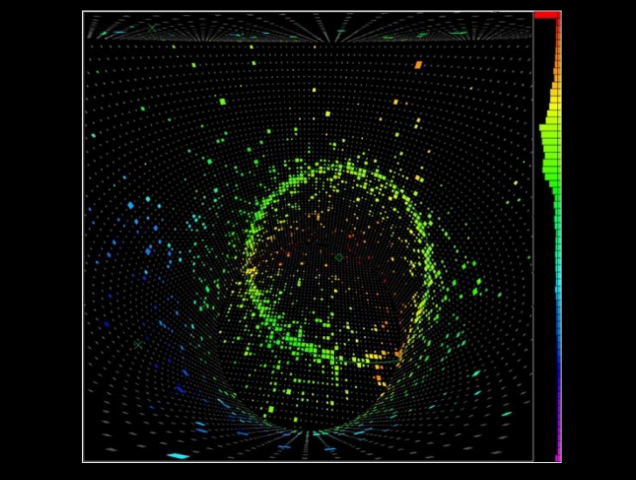Research News
Mar 25, 2025
- Science
First joint oscillation analysis of super-kamiokande atmospheric and T2K accelerator neutrino data
Super-Kamiokande imaging
Electron neutrino reactions detected by the Super-Kamiokande detector.
Credit: Osaka Metropolitan University

The Super-Kamiokande and T2K Collaborations present a joint measurement of neutrino oscillation parameters from their atmospheric and beam neutrino data. It uses a common interaction model for events overlapping in neutrino energy and correlated detector systematic uncertainties between the two datasets, which are found to be compatible. Using 3244.4 days of atmospheric data and a beam exposure of 19.7(16.3) x 1020 protons on target in (anti)neutrino mode, the analysis finds a 1.9𝜎 exclusion of 𝐶𝑃 conservation (defined as 𝐽𝐶𝑃 = 0) and a 1.2𝜎 exclusion of the inverted mass ordering.
The Super-Kamiokande (SK) experiment measures atmospheric neutrino oscillations using a large multipurpose water Cherenkov detector located in the Kamioka mine in Gifu, Japan.
The Tokai-to-Kamioka (T2K) long-baseline neutrino experiment measures neutrino oscillations over a baseline of 295 km using a primarily muon (anti)neutrino beam produced by the neutrino facility at J-PARC, located in Ibaraki, Japan.
Paper information
Journal: Physical Review Letters
Title: First Joint Oscillation Analysis of Super-Kamiokande Atmospheric and T2K Accelerator Neutrino Data
DOI: 10.1103/PhysRevLett.134.011801
Authors: Y. Seiya, K. Yamamoto, et al. (Super-Kamiokande Collaboration and T2K Collaboration)
Published: 2 January 2025
URL: https://doi.org/10.1103/PhysRevLett.134.011801
Contact
Kazuhiro Yamamoto
Graduate School of Science
Email: kazuhiro[at]omu.ac.jp
*Please change [at] to @.
SDGs
